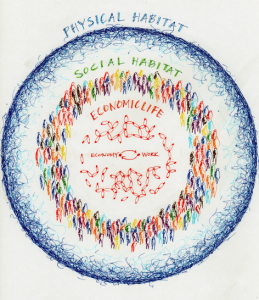Thinking of our cities as nests means we understand that our cities are what we build for ourselves. Like other species we build our most immediate habitat: our shelter from the elements. We also build structures that, once our survival needs are met, nurture our families and our well-being. As a collective, we build larger and larger communities that address the needs of more than just a family. Over the course of our evolution we build infrastructure to protect ourselves and our livelihoods (fortifications) and we build infrastructure to ensure order (transportation systems, government facilities). We also build infrastructure to enjoy the opportunities that present themselves to enjoy life (recreation facilities, art galleries, sports arenas, etc.). All of this is enabled because of our relationship with the resources that surround the beginnings of settlement and the subsequent work we have developed and expanded over decades, centuries and millenia.
Consider a simple definition of nest – a place or structure made or chosen:
- in which to lay and incubate eggs or give birth to young
- where a number of animals of the same species and their young occupying a common habitat: an ants’ nest
- where an animal or insect breeds or shelters: an ants’ nest
The qualities of a nest are various. A nest has some density. Perhaps as a snug retreat, or tucked away all by itself, it is where a concentration of a species calls home. A nest is also warm, safe and comfortable. Whether a nest for birds, or a nest of shredded paper to hold a fragile bowl, a nest is a container that holds, protects and supports its contents. A nest is pocket-like, usually a more or less circular structure. It is a refuge from the elements. It is home.
At a basic level, “nest” describes the habitat humans build for themselves very appropriately. Our cities are made by us. We build our homes and cities for ourselves as a species and with each generation. More and more humans are choosing cities as their habitat. In addition, cities provide heightened care for our young (specialized health care).
The qualities of a nest also coincide with those of a city. People conglomerate in the city. The city – at its best – provides shelter for more and more humans as more and more humans make cities their home. At a minimum, we go to cities with the intention of making a better life, pursuing our work, looking for opportunities. Geographical constraints aside, our cities take a circular form. Cities are the habitat that holds, protects and supports the generation of new ways of thinking, making and doing new things. Cities cultivate innovation, the very thing we need to ensure the cities we build are able to hold, protect and support us, citizens of the city. We make the nest – the city – in which we settle.
In exploring definitions of nest, I found that as soon as the word nest is associated with humans, a shadow side emerges: a place filled with undesirable people, activity or things; a place or situation that is full of bad people or activities; or a place that fosters something undesirable. The examples: a nest of spies, a nest of thievery. It certainly is the case that as more and more good things happen in the city, more bad things will also take place. The city is not a perfect phenomenon. Our work in cities must acknowledge and attend to the healthy and unhealthy aspects of our nest. Which do we wish our city nests to nurture?
We build our nest cities to serve ourselves – to survive and thrive. We build our nest cities to allow us to grow and develop – to emerge into what we need to be in order to survive and thrive. We have a choice about whether to create cities that serve us poorly or well. They are the place from which we leap to new ways of thinking, making and doing new things. They are the place from which we fly to new nests, as we reshape our cities and what happens in them now at an unprecedented rate.
As we think about our nest cities and our relationship with them, we must consider the nested hierarchy of systems that make up the city (Figure A). (Three posts have explored the nested hierarchy of city systems: Work at scale to serve the city, The development of cities is a survival skill, and Cities: the result of our evolving interaction with our habitat.) A city is full of similar things of different sizes that fit inside each other, where the smaller element fits in a lower position in a hierarchy: a nest of tables, organisms classified in a series of nested sets. This involves a set of things in graduated sizes that fit together. The notion of hierarchy offers yet another way of looking at the city and its systems.
There is a lot for a Nest City to hold. It is simple and complex and it is ever changing. Knowing this changes how we look at our cities. It changes how we design our cities. It changes the very process by which we create our cities. Nest City requires us to host ourselves and our evolution well.

Resources that may be of interest
Definitions:
Synonyms: